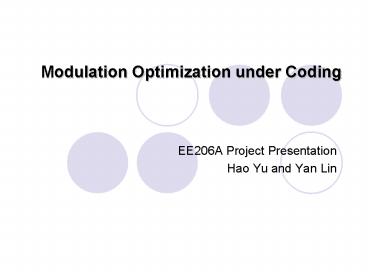Modulation Optimization under Coding - PowerPoint PPT Presentation
1 / 15
Title:
Modulation Optimization under Coding
Description:
The energy of A/D and D/A converters is not included in the model as it will the ... The computation of Viterbi decoding is exponential with the Kc ... – PowerPoint PPT presentation
Number of Views:21
Avg rating:3.0/5.0
Title: Modulation Optimization under Coding
1
Modulation Optimization under Coding
- EE206A Project Presentation
- Hao Yu and Yan Lin
2
System Model
- The energy of A/D and D/A converters is not
included in the model as it will the - introduce quantization noise.
- Assume the power consumption of mixer, frequency
synthesizer and low noise - amplifier can be approximated to be independent
of B. - When modulation bandwidth B is much smaller than
the carrier frequency fc - The circuit energy is a linear function of active
time Ton as a first order - model.
3
General Circuits Energy Model
Table 1. Table of power consumption of general
circuit components
- The start-up time for other circuit blocks is
negligible compared to that of the - frequency synthesizers.
- The optimal strategy for the start-up process
- first turn on the frequency synthesizers
- once settle down, turn on the rest of the
circuits. - The resulted transient energy consumption is
merely from frequency synthesizer. - We denote this transient time as Tstartup.
4
Receiver Decoding Energy Scaling
- Functions of the convolutional code with use of
dynamic voltage scaling. - The computation of Viterbi decoding is
exponential with the Kc - fmax represents the maximum clock frequency, and
f represents - the actual frequency
- To first order, the relation between core voltage
VDD and frequency - f is linear.
- Given a latency constraint of T on the decoding
of N useful - bits of data, we can solve for the required VDD.
The reverse will be the same.
5
(No Transcript)
6
Transmitter Radio Energy Model
N the number of data bits before FEC R the radio
bit rate Rc the convolutional code rate
7
Received Signal Power under Different Modulation
MPSK
MQAM in AWGN Channel
8
Coding/un-coding BER vs. Eb
Figure 1(a). BPSK BER vs. Eb/N0
Figure 1(b). BPSK BER vs. Ptx at d500m
Figure 2(a). 8-PSK BER vs. Eb/N0
Figure 2(b). 8-PSK BER vs. Ptx at d500m
Figure 1(a). BPSK BER vs. Eb/N0
Figure 1(b). BPSK BER vs. Ptx at d500m
Figure 1(a). BPSK BER vs. Eb/N0
9
Precv Table Function for Coding
10
Coding Effect to Transmission Power
d 0 to 1000m MPSK
Generally add coding will decrease the
transmitter power
11
System Energy Model
Transient Energy is small compared to circuits
energy Leakage consumption is only considered for
receiver decoding First fix Vdd 1.15V (minimum
for decoding) to observe the relation with
modulation Then also change Vdd.
12
Energy vs Modulation Level (I)
(a) d 0 to 500m for MPSK
- Coding overhead is large
- When d is small keep turning on transmitter has
no benefit - for un-coding case
- The modulation scaling is better to be applied
for coding
13
Energy vs Modulation Level (II)
(b) d 500 to 1000m for MPSK
- Coding overhead is small
- The range for modulation scaling is small for
un-coding - The modulation scaling is better to be applied
for coding
14
Energy vs Modulation Level (III)
d 500 to 1000m for MQAM
d 0 to 500m for MQAM
- Coding overhead is large
- The modulation scaling can be applied for both
cases
15
Energy vs System-Latency
T Ttx Trx Ts
d 0 to 1000m for MQAM
d 0 to 1000m for MPSK
16
Energy vs. Vdd (decoding) and M (modulation level)
d 5, 500, 1000m MQAM Energy vs. Vdd and M
d 5, 500, 1000m MPSK Energy vs. Vdd and M
d is small (d5m) Vdd dominates and DVS is
meaningful d is medium (d500m) MPSK Vdd and
modulation level are both important MQAM
Modulation has more important contribution d is
large (d1000m) M dominates and DMS is more
meaningful































